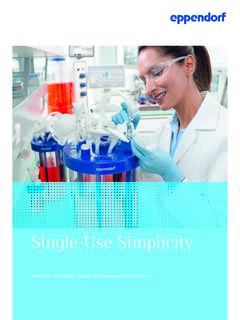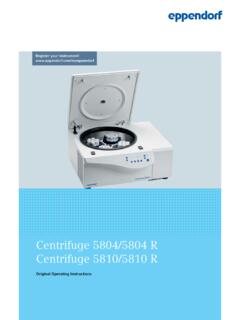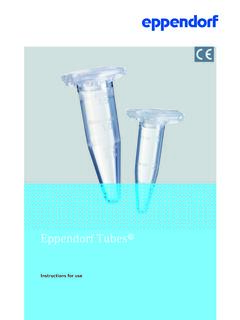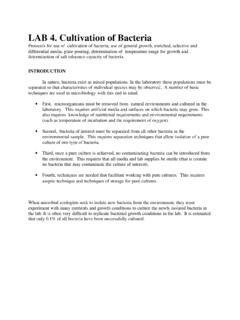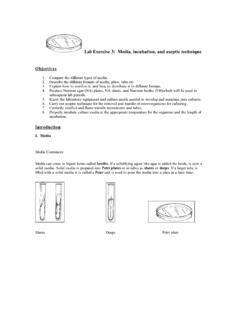Transcription of Bioprocessing Basics - Eppendorf
1 JUNE 2020 Bioreactors and Fermenters: Powerful Tools for Resolving cultivation BottlenecksUlrike RascheAdvanced Technologies Facilitate Scale-up and Technology TransferCynthia ChallenerA Beginner s Guide to Bioprocess Modes: Batch, Fed-Batch, and Continuous FermentationYing Yang and Ma ShaBioprocessing BasicsSponsored byThis custom ebook is sponsored by Eppendorf and presented in partnership with BioPharm Up, Tech TransferFermentationBioreactors and Fermenters JUNE 2020 | BIOPHARM INTERNATIONAL SPONSORED CONTENT2 SPONSORED CONTENT application noteBioreactors and Fermenters: Powerful Tools for Resolving cultivation BottlenecksUlrike RascheBioreactors and Fermenters: Powerful Tools for Resolving cultivation BottlenecksShake flasks, cell culture dishes, and T-flasks are the first vessels that come to mind when we think about cultivation systems for growing eukaryotic and prokaryotic cells in the lab.
2 Bioreactors and fermenters are another alternative to consider if we need larger quantities of cells, increased efficiency of cultivation , or enhanced reproducibility. In this white paper, we explain the key characteristics of stirred-tank bioreactors and which organisms are typically grown in them. Using specific examples, we demonstrate how bioreactors and fermenters can help to resolve cultivation applications are well served by the cultivation of bacteria or yeast in shake flasks and cells in dishes or T-flasks. Bioreactors and fermenters, however, improve productivity and save work, time, and lab space for scientists, who: need large quantities of cells, microbes, or the products they express would like to improve the reproducibility of growth, the product formation, or the product quality would like to systematically compare different growth conditions would like to increase the cultivation efficiencyScale Up, Tech TransferFermentationBioreactors and Fermenters JUNE 2020 | BIOPHARM INTERNATIONAL SPONSORED CONTENT3 What are bioreactors and fermenters?
3 Broadly speaking, bioreactors and fermenters are culture systems to produce cells or organisms. They are used in various applications, including basic research and development, and the manufacturing of biopharmaceuticals, food and food additives, chemicals, and other products. A broad range of cell types and organisms can be cultivated in bioreactors and fermenters, including cells (like mammalian cell lines, insect cells, and stem cells), microorganisms (like bacteria , yeasts, and fungi), as well as plant cells and and fermenter are two words for basically the same thing. Scientists who cultivate bacteria , yeast, or fungi often use the term fermenter. The term bioreactor often relates to the cultivation of mammalian cells, but is also generically used. When we talk about bioreactors in this white paper, we usually mean systems for the cultivation of microbes or mammalian bioreactorsThough many types of bioreactors exist, we will focus on stirred-tank bioreactors.
4 The name is accurately descriptive. cultivation takes place in the bioreactor tank often called a vessel and the culture is mixed by stirring (instead of shaking, for example). Stirred-tank bioreactors come in different sizes (for cultures of a few milliliters to thousands of liters) and are made of various materials (usually glass, plastic or stainless steel). The basic components and functioning of stirred-tank bioreactors are always the same. A stirred-tank bioreactor system consists of several parts (Figure 1): A vessel that is filled with the medium in which cells are cultivated A head plate to close the vessel Components within or attached to the vessel or the head plate to Bioreactors and Fermenters: Powerful Tools for Resolving cultivation BottlenecksFigure 1: Stirred-tank bioreactor system consisting of bio-process control station, vessel, and bioprocess control soft-ware.
5 The BioFlo 120 bioprocess control station is shownScale Up, Tech TransferFermentationBioreactors and Fermenters JUNE 2020 | BIOPHARM INTERNATIONAL SPONSORED CONTENT4measure and adjust the culturing conditions, such as feed lines and sensors A control system comprising external components used to adjust the culturing conditions ( , pumps) and control softwareCreating optimal cultivation conditionsLike incubators and shakers, bioreactors allow for the creation of optimal environmental conditions for the growth of cells or microbes. They differ, however, in how these are mixing. Instead of mixing by shaking, in a bioreactor, the culture is stirred with an impeller.
6 The impeller is mounted to the impeller shaft, which in turn is connected to a motor. In a bioreactor, not only are bacterial, yeast, and suspension cell cultures constantly mixed, but so too are the cultures of adherent cells attached to a growth To obtain the right cultivation temperature, a bioreactor does not need to be placed inside a shaker or incubator but can remain on the lab bench. The temperature of the culture medium is continuously monitored with a temperature sensor. To regulate it, the vessel is placed in a thermowell, wrapped with a heating blanket or has a water jacket. Cooling is possible as aerobic or anaerobic conditions. In a shaker or incubator, oxygen is transferred from the surrounding air to the culture medium. This process is more efficient in shake flasks than in static cultures because shaking increases exposure of the liquid surface.
7 In bioreactors, air or pure oxygen (coming for example from a compressed air cylinder) is usually introduced to the culture. With the use of spargers, the gas/liquid interface can be increased and the oxygen supply maximized. Oxygen is important for culture growth, and the amount of oxygen dissolved in the medium (dissolved oxygen concentration, DO) is continuously measured with a DO keep DO at setpoint, a DO cascade is often set up in and executed by the bioprocess control software. Figure 2 shows an example for a typical DO cascade. If DO drops below setpoint, first the agitation speed is gradually increased up to 1,200 rpm to increase oxygen transfer from the surrounding air. If this Bioreactors and Fermenters: Powerful Tools for Resolving cultivation BottlenecksFigure 2: Dissolved oxygen cascadeScale Up, Tech TransferFermentationBioreactors and Fermenters JUNE 2020 | BIOPHARM INTERNATIONAL SPONSORED CONTENT5is not sufficient to keep DO at setpoint, the gas flow rate is increased up to three standard liters per minute (SLPM).
8 As a final measure, the oxygen concentration in the gas mix is increased, shifting from gassing with air (containing 21% oxygen) toward gassing with pure oxygen. This is just an example. The minimum and maximum values of agitation, gas flow rate, and oxygen concentration can be optimized depending on the organism and process conditions can be established by gassing with N2 or other anaerobic control. To regulate the pH of carbonate-buffered cell culture media, cell cultures in flasks or dishes are usually placed in CO2 incubators. In bioreactors, the principle is the same; CO2 is introduced to the culture from a compressed gas cylinder. In bioreactors, the medium pH is continuously measured using a pH sensor and CO2 is added as needed. This is different from the situation in a CO2 incubator, in which the CO2 concentration in the internal incubator atmosphere is measured and controlled, rather than the medium pH.
9 Bioreactors also differ in that a basic solution is often added to compensate for acidification during culture microbial cultures in bioreactors, basic and acid solutions are commonly used for pH adjustment. This is different from cultures in shake flasks, where the culture pH is usually not of parameters at setpoint. In bioreactors, different components and the control software play together to control pH, temperature, and dissolved oxygen at the desired setpoint. The parameters are constantly measured using pH, temperature, and DO sensors. The sensors transmit the information to the bioprocess control software, which regulates the addition of CO2 and liquid pH agents, the activity of tempering devices, agitation, and the gassing with air and/or typical bioprocess runTo maintain cultures, scientists usually keep them in cultivation systems within incubators.
10 Bioreactors are usually used for a specific experiment or production run, which may last hours, days, or weeks, depending on the organism and application. A bioprocess run typically comprises the following steps (Figure 3):Bioreactors and Fermenters: Powerful Tools for Resolving cultivation BottlenecksBioProcessing IntroductionSponsor s ContentScale Up, Tech TransferFermentationBioreactors and Fermenters JUNE 2020 | BIOPHARM INTERNATIONAL SPONSORED CONTENT61. Preculture: The medium in the bioreactor is inoculated with a preculture. Often, the preculture is grown in a shaker or incubator. Sometimes, smaller bioreactors are used to grow precultures for the inoculation of larger Bioreactor preparation: The bioreactor is prepared in parallel to inoculum preparation.


